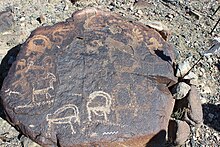Shyrdak
In 2012, Kyrgyz felt carpets ala-kiyiz and shyrdak were inscribed into the UNESCO List of Intangible Cultural Heritage of Humanity in need of urgent protection.
[3] The history of felt production in Eurasia can be traced to the end of Bronze Age when sheep, goat, and horse herding were common activities of nomadic farmers of the region.
[4] In the burial mounds of the mountainous Altai region, Eastern Kazakhstan and Mongolia, many households, farming, and warfare items were discovered, including felt carpets that utilized mosaic, applique and quilting techniques, demonstrating a rich aesthetic and high level of skill.
[4] The Shyrdak is usually designed in an inlaid patchwork of highly contrasting colours[10] such as red and green, yellow and black, brown and white.
Once the wool is dried a brightly coloured pattern is laid on to a plain background this is then soaked with soap and water rolled up and literally pressed this process is repeated.




